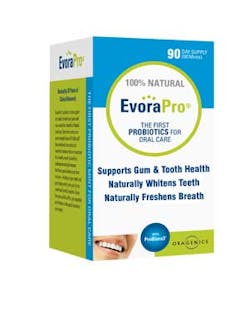Probiotics and their impact on oral health
ProBiora3 contains freeze-dried strains of bacteria delivered in the form of a quick dissolving mint. When the beneficial bacteria make contact with saliva, they are activated and begin to “wake up.” The three strains of living bacteria then attach themselves to the surface of the teeth and migrate deep below the gumline into the periodontal pocket; they become the colonization center of beneficial bacteria to support oral health.
Studies have indicated that the type of bacteria that colonizes first in the base of the clean pocket after aggressive scaling and root planing treatment predicts the future oral health of the periodontal pocket. The disease condition will quickly return if the harmful bacteria are the first to colonize resulting in further periodontal disease.
If the beneficial bacteria are the first to colonize, good oral health will be established and the dental office procedure will have been successful. In a recent clinical trial involving ProBiora3, plaque samples taken from the bottom of the periodontal pocket produced a noticeable reduction in the levels of harmful bacteria. We can therefore conclude, oral probiotics can safely and effectively help manage a healthy balance of the oral micro flora necessary to sustain ongoing periodontal maintenance.
However, that is not the only benefit of oral probiotics. Oral probiotics may help to prevent dental decay as well. Streptococcus mutans (S. mutans) in the oral cavity convert sugar into lactic acid. Lactic acid is the bacterial byproduct believed to be responsible for dental caries and the erosion of tooth enamel. The probiotic bacteria S. rattus JH145 specifically targets the reduction of acidogenic S. mutans in the oral cavity. When lactic acid is not being produced, healthy tooth enamel is maintainable.
Other appealing benefits of ProBiora3 to patients are teeth whitening and fresher breath. S. oralis KJ3 and S. uberis KJ2 crowd out harmful bacteria by competing for the same nutrients and surface space, thus creating a healthy balance of microflora. Actively lowering the levels of those bacterial species that produce volatile sulfur compounds results in a long-lasting, breath freshening effect.
S. oralis KJ3 and S. uberis KJ2 naturally produce low concentrations of hydrogen peroxide. The natural production of hydrogen peroxide gradually whitens teeth and is a pleasant benefit of ProBiora3. The makers of ProBiora3 report that in laboratory studies, the low-dose hydrogen peroxide produced by the S. oralis KJ3 created a whitening benefit that continued to improve over the duration of the study. As this good bacterium is replenished daily, it creates gradual whitening with the full benefits of long contact times.
Stress, certain medications, poor oral hygiene homecare, and dietary or other lifestyle changes are factors that are constantly changing the proper bacterial balance in the oral cavity. Probiotics are used to compliment ongoing long-term maintenance and a healthy oral ecosystem and do NOT cure disease. Probiotics should not be used in place of conventional medical/dental care or to delay seeking care if someone is experiencing concerning symptoms, but in concert with the recommended daily hygiene regimen; brush, floss, take your probiotics before bed-time!
Best of all, probiotics such as ProBiora3, are safe and 100% natural. There are no contraindications in otherwise healthy patients. Immuno-suppressed or compromised patients are strongly encouraged to seek their physician’s approval prior to the initiation of a course of any probiotics.
EvoraPro by Oragenics is produced in the USA, is carefully manufactured to be soy, wheat, nut, and gluten free, and contains no artificial sweeteners, flavors or colors.
References
Deepa D., Mehta DS. Is the role of probiotics friendly in the treatment of periodontal disease!! PubMed. 2009, Jan 13. Available at http://www.ncbi.nlm.nih.gov/pmc/articles/PMC2846672/?tool=pubmed. Accessed 8/27/12.
Levitt IA, Gregory RL. (2012). Antibiotics and dental biolfilms. Dimensions of Dental Hygiene, 10(1), 56-59.
Oral Probiotics. Available at http://www.oragenics.com/?q=probiotics. Accessed 2/7/12.
Socransky SS, Haffajee AD. (1992). The bacterial etiology of destructive periodontal disease: Current concepts. Journal of Periodontology, 63(4), 322-331.
Van Essche M., Loozen G., Godts C., Boon N., Pauwels M, Quirynen M, Teughels W., 2012, Aug 16. Available at http://www.ncbi.nlm.nih.gov/pubmed/22897652. Accessed 8/27/12.
J Appl Microbiol. 2009 Aug;107(2):682-90. Epub 2009 Mar 30. Preliminary assessment of safety and effectiveness in humans of ProBiora3, a probiotic mouthwash. Zahradnik RT, Magnusson I, Walker C, McDonell E, Hillman CH, Hillman JD.


